Abstract
This paper offers a prospective solution to the poor quality and less prominent features of the original terahertz spectral images of unsound wheat grains caused due to the imaging system and background noise. In this paper, a CBDNet-V terahertz spectral image enhancement model is proposed. Compared with the traditional algorithms, the peak signal-to-noise ratio (PSNR) and structural similarity (SSIM) of the obtained enhanced images using the proposed model show performance improvement. As validated by the ResNet-50 classification network, the proposed model processes images with an accuracy of 94.8%, and the recognition accuracy is improved by 3.7% and 1.9%, respectively, compared to the images with only denoising and feature extraction. The experimental results indicate that the deep learning-based terahertz spectral image technology for unsound wheat kernels has good prospects in the identification of unsound wheat kernels.
1. Introduction
Wheat cultivation has become a major agricultural industry for economic development. Due to its importance, wheat quality research has become a focus of grain research [1,2]. Unsound wheat kernels, such as sprouted and mold grains, are an important factor in evaluating wheat quality. The grains are usually damaged by a mechanical process or microbial attack on the embryo or endosperm, thus causing the grain quality to decline. The detection of unsound wheat grains is crucial for evaluating the quality of wheat grains, as the content of unsound wheat grains is a critical indicator for grading and ranking wheat.
Carloni et al. [3] used multiplex real-time PCR based on a dual-labeled probe strategy to detect normal wheat in durum wheat. Allmann [4] and Garcia et al. [5] used manual detection methods for performing quantitative analysis of wheat in real-time. However, it is noteworthy that the manual wheat testing methods are laborious, have poor testing accuracy, and are very subjective. Zhao et al. [6] used an Unmanned Aerial Vehicle (UAV) for photographic inspection of wheat and solved the problem of wheat spike detection errors and missed detection due to shading conditions—this work provided a technical reference for wheat phenotype monitoring. Sabanci [7] and Qiu et al. [8] used machine vision methods for the detection of pests and blast wheat. However, these methods cannot obtain the internal information of wheat, such as fats and maltose [9], and cannot provide early, comprehensive and multi-level detection of wheat. Cebi et al. [10] identified and classified the unadulterated and adulterated samples successfully based on Raman spectroscopy. The results showed that both the adulterated and unadulterated samples were correctly identified with 100% accuracy. Zhang [11] and Wu et al. [12] used the hyperspectral imaging technique to determine the type of wheat seeds. The results showed that classifying wheat seeds based on hyperspectral imaging is a feasible technique. Although the traditional machine vision methods achieve appropriate wheat classification and recognition accuracy, they still have some limitations, such as slow imaging speed, a small amount of information, low penetration, and poor real-time performance.
Terahertz is an emerging technology that carries rich physical and chemical information regarding biomolecular interactions due to its low photon energy, high penetration power, and fast molecular resonance response. In addition, it has the advantage of collecting both spectral and spatial information. The terahertz technology has proven to be a scientifically effective method for detecting food quality. Sun et al. [13] proposed a combination of terahertz and Least Squares Support Vector Machines (LS-SVM) to determine benzoic acid (BA) additives in wheat flour. The results showed that the quantitative analysis of BA additives in wheat flour could be effectively accomplished using this method. As a result, this method can be an effective tool for wheat flour quality control. Shen et al. [14] proposed a wheat impurity detection method by combining terahertz spectral imaging and a convolutional neural network (CNN). The results showed that this method effectively identifies the impurities in wheat with an accuracy of 97.83%. Zhang et al. [15] used terahertz imaging to determine the feasibility of BB-resistant seeds and compared the performance of CNNs with traditional machine learning methods, including support vector machine (SVM), random forest (RF), and partial least squares discriminant analysis (PLS-DA). The results showed that the combination of terahertz imaging technology and CNN has a significant potential for rapid identification of BB-resistant rice seeds.
The terahertz technology has made significant contributions to wheat quality inspection. However, the devices, such as ultrafast lasers and terahertz detectors, are prone to generate dark current noise, short noise, and thermal noise during terahertz image acquisition. This affects the quality of terahertz images. Therefore, further improvement of terahertz image quality and resolution is needed. Some researchers have improved terahertz detectors in terms of hardware to increase their detection sensitivity and improve detection accuracy. Zhai et al. [16] designed and developed a terahertz detector based on graphene nanowebs. The experiments showed that the sensitivity of this detector can reach 2.5 A/W at room temperature by using the energy gap of graphene nanostructures for enhanced plasma excitation, which can achieve the highly sensitive detection of terahertz waves.
Some researchers proposed the use of algorithms to enhance the original terahertz spectral image. For example, Chen et al. [17] used an image denoising algorithm with Gaussian kernel weighted mean filtering and nonlinear contrast transform. They combined Markov chain Monte Carlo (MCMC) with the M-H sampling method. The results showed that this algorithm has superior performance in terahertz image denoising experiments. Liu et al. [18] proposed a terahertz image denoising algorithm by combining the ant colony algorithm and adaptive threshold denoising algorithm. This method outperformed the traditional terahertz image denoising method and improved the image quality. Zhang et al. [19] applied the wavelet denoising technique to process terahertz time-frequency signals to recover the details in IC images. The results showed that the denoised recovered images exhibit better performance in the peak signal-to-noise ratio and visual improvement. Although the traditional image enhancement algorithms solve the problems of image detail optimization, the currently available algorithms for terahertz spectral image processing are commonly based on machine learning techniques with simple network structures. These methods do not consider the impact of different types of noise on an image, thus failing to perform an all-round and multi-level processing of terahertz images. As a result, the terahertz spectral images suffer from various degradations, such as image features not being prominent.
In this work, we propose a deep-learning-based terahertz spectral image enhancement algorithm for unsound kernels of wheat, namely the Convolutional Blind Denoising- Visual Geometry Group (CBDNet-V) based on Convolutional Blind Denoising (CBDNet) and the Visual Geometry Group (VGG19). Considering the problem that the original unsound kernels of wheat terahertz spectral image features are not prominent, the proposed method used CBDNet-V to enhance the features of unsound kernels. Then, the ResNet-50 was applied to discriminate wheat in terahertz spectral images.
2. Equipment and Algorithm Principles
2.1. Experimental Setup and Principles
The terahertz (THz) instrument used in this work is a Z3 series THz time-domain spectrometer from Zomega Corporation, USA, with an effective spectral range of 0.1~3.5 THz, a peak dynamic range greater than 1000 (70 dB), and a system signal-to-noise ratio greater than 3000. The basic optical path structure of the system is shown in Figure 1. After passing through the beam splitter, the femtosecond laser was divided into two beams. The first beam is for the pump light, and the second beam is for the detection light. The pump light was used to excite the transmitter to generate terahertz waves, and the detection light is used to excite the detector to detect the terahertz light. The delay line regulates the relative time relationship between the pump pulse and the detector pulse, which subsequently triggers the detectors together to obtain the time domain signal of a sample. All terahertz signals were assembled together to finally construct a terahertz image of the sample.

Figure 1.
THz electromagnetic spectrum and the terahertz gap. (a) Basic optical path structure of the system; (b) THz spectrum of the sample; (c) THz image of the sample.
2.2. Principle of the Proposed Algorithm
2.2.1. CBDNet
CBDNet is a realistic noise model that comprises a noise estimation subnetwork and a non-blind denoising subnetwork. This model enables us to perform blind denoising of images where the levels of noise are unknown [20]. The noise estimation sub-network converts the noisy observed image y into an estimated noise level map . . The noise estimation sub-network adjusts before inputting it to the non-blind denoising sub-network. The non-blind denoising network then takes y and as inputs and learns the residual mapping based on residual learning to obtain a noise-free image .
CBDNet uses asymmetric loss functions for noise estimation, given pixel with the estimated noise level and true value , when , increasing the penalty for underestimating the network noise level. The noise estimation loss function is mathematically expressed as follows:
when , and zero otherwise.
In this work, by setting , more penalties for underestimation errors are introduced. In addition, the network introduces a full variational () regular term constraint on the smoothness of
, which yields the following:
where and represent the gradients in the vertical and horizontal directions, respectively. For the non-blind denoising sub-network output , the reconstruction error is mathematically expressed as:
Thus, the objective loss function for the whole CBDNet network is mathematically expressed as:
where and denote the weights corresponding to and .
The CBDNet uses synthetic noise images together with the real noise images for training the model [21]. This model improves the denoising effect of the network. The loss function for asymmetric learning is also proposed, which adjusts the denoising results interactively in the network to further enhance the denoising effect.
2.2.2. VGG19
VGG19 is a classical convolutional neural network with excellent feature extraction performance [22]. VGG19 consists of five convolutional layers and three fully connected layers. In VGG19, each convolutional layer adopts a 3 × 3 convolutional kernel, which consists of one or four convolutional layers stacked to form a convolutional sequence. It uses a boundary filling technique to achieve a larger perceptual field while keeping the dimensions unchanged. The convolutional layers contain a 2 × 2 pooling window with a pooling layer of step 2 after the convolutional layer, which is used to reduce the feature parameters. And VGG19 can directly output the image corresponding to the features by the input features when extracting features from the image.
2.2.3. ResNet50
The Residual Net-work (ResNet) contains 49 convolutional layers and one fully connected layer [23], as shown in Figure 2. The IDBLOCKx2 in the second to the fifth stage represents two residual blocks without changing the size, and CONVBLOCK represents the residual blocks with added scale. Each residual block contained three convolutional layers. Thus, there exist 1 + 3 × (3 + 4 + 6 + 3) = 49 convolutional layers, and together with the last fully connected layer of the network, it constituted a 50-layer structure. Finally, the classifier calculated and outputted the category probability structure. It is noteworthy that the ResNet50 consists of jump connections between the convolutional layers. These connections allowed for information to propagate across multiple implicit layers, thus effectively alleviating the gradient disappearance and network degradation problems that are common in deep neural networks [24].

Figure 2.
The architecture of the ResNet50 network.
2.3. CBDNet-V Terahertz Spectral Image Enhancement Model
This work proposes CBDNet-V for enhancing the terahertz spectral images of unsound kernels of wheat, as presented in Figure 3. In the original network, the noise class estimation is not accurate enough. Consequently, the obtained noise level map cannot effectively simulate the original image. In this work, we propose a more realistic estimation of the original image by using non-uniform Gaussian (HG), in-camera processing (ISP), salt-and-pepper noise (SPN) [25] and gamma noise (GN) [26] in the noise estimation sub-network in conjunction with the noise present in the acquisition of terahertz spectral images of unsound wheat grains. A new seven-layer convolutional network with a convolutional kernel of size 3 × 3 × 32 is proposed to replace the original convolutional network. Considering the possible gradient disappearance and overfitting due to the depth of the network, we used a parametric rectified linear unit (PReLU) [27] as the activation function.
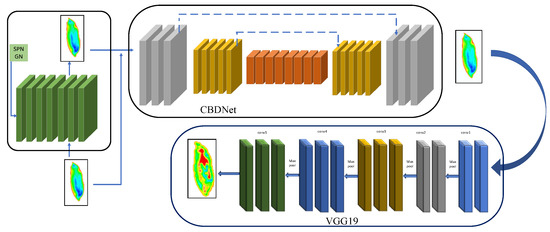
Figure 3.
The terahertz spectral image enhancement model for unsound kernels of wheat.
The PReLU is mathematically expressed as follows:
where denotes the parameter that degenerates to ReLU if , and PReLU degenerates to Leaky ReLU (LReLU) if is a very small and fixed value. In this paper, is initialized to 0.25.
The training process of the original CBDNet non-blind denoising sub-network has a low level of feature abstraction, which affects the denoising effect. In order to address this problem, in this work, we propose a non-blind denoising sub-network to enhance the denoising ability of this network. We used a 33-layer U-Net and enhanced the maximum feature map to 512 for extracting the image features at a deeper level. Additionally, we chose PReLU as the activation function to solve the problem of gradient disappearance and overfitting.
In this work, in order to avoid the problems such as gradient disappearance and overfitting in the VGG19 network during feature extraction, we used PReLU instead of the original ReLU activation function to maintain the quality of the output image. Moreover, we removed all the fully connected layers to increase the accuracy of extracting features as well as retaining the ability to extract features.
The pepper noise is caused by the image sensor, transmission channel, decoding process, etc. Usually, the pepper noise is viewed as a variable in the image, represented by the variable . The probability density function of satisfies the following:
where , and correspond to the noise points in an image.
We set in gamma noise to be a noise with a mean of 1, which follows a distribution. The probability density function is mathematically expressed as:
where denotes the number of independent imaging of the same scene and is the Gamma function.
2.4. Evaluation Indicators
The traditional image quality evaluation metrics included a peak signal-to-noise ratio (PSNR) [28], mean-squared error (MSE) [29] and structural similarity index (SSIM) [30]. The aforementioned criteria can be extended to terahertz spectral images.
The MSE is mathematically expressed as follows:
where denotes the pixel value of the reconstructed image at , denotes the pixel value of the original image at , and and represent the size of the image.
The PSNR was used to measure the proximity of two images and reflects the statistical average of the change in the image signal-to-noise ratio.
The Max value depends on the maximum value in the image. The common Max ranges from 0–255, and usually, the value of Max is 255. It is easier to compute and understand PSNR. In addition, it effectively reflects the reconstruction quality. Usually, the higher the PSNR, the better the quality of the reconstructed image.
The SSIM is a metric used to evaluate the degree of structural similarity between two images. It is mathematically expressed as follows:
where and denote the average gray values of images and y, respectively, and denote the standard deviations of images and , respectively, and represents the number of interrelationships between images and . and C2 are mathematically expressed as follows:
where , , and denotes the range of gray levels in image and . The larger the SSIM of two images, the higher their structural similarity.
3. Experiments and Results
3.1. THz Spectral Image Data Acquisition of Wheat Unsound Grains
We used three groups of samples in the experiments, including normal wheat kernels, sprouted wheat kernels and moldy wheat kernels. These samples were obtained from the national grain reserve. These samples were acquired in 2021. The experiments were performed using a THz-TDS system. The wheat samples were individually placed on a moving platform in the THz-TDS system for reflectance imaging measurements. The maximum scanning area of the system is 50 mm × 50 mm, and the spatial resolution was set to 0.1 mm. A complete THz waveform can be acquired at each pixel position with 512-time domain points in the time range of 30 ps, corresponding to a frequency range of 0–3.5 THz. The resulting terahertz spectral image contained the spatial information and the spectral information. The obtained sample partial THz spectral image is shown in Figure 4.
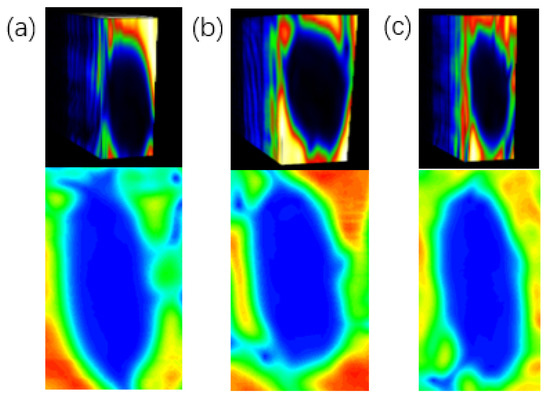
Figure 4.
Original terahertz spectral image of wheat. (a) Normal wheat; (b) moldy wheat; (c) sprouted wheat.
3.2. Network Training
The terahertz spectral image enhancement model is trained based on the experimentally acquired THz spectral images of normal wheat grains, sprouted wheat grains and moldy wheat grains. The experiment selected a total of 300 grains of normal wheat grains, sprouted wheat grains and moldy wheat grains. The same sample and 500 THz spectral images in different frequency domains constituted a set, which was finally divided into training and test sets in a ratio of 9:1.
In this work, we used NVIDIA GTX 1080Ti GPU, Windows 10, TensorFlow, and Python for training the network. In order to train the network, we first removed the background from the original terahertz images and preserved the wheat part. Then, the training samples and their corresponding labels were used as the input of the proposed network for noise removal and feature extraction, and the wheat grain feature maps were extracted. The classification images are divided into training sets and labels and input into ResNet50 for classification.
3.3. Experimental Results and Discussion
Figure 4 shows that the normal wheat grains, sprouted wheat grains and moldy wheat grains had a large amount of background interference, and the image quality was poor. The average spectra presented in Figure 5 show that the normal wheat kernels, sprouted wheat kernels and moldy wheat kernels had strong signals at 0.2 THz, and the signals were relatively weak after 0.8 THz. In this work, we choose the frequency domain spectral images of normal, sprouted and moldy wheat seeds at 0.2 THz for experimental testing and perform background denoising to keep the wheat seeds. The background removed images are presented in Figure 6.
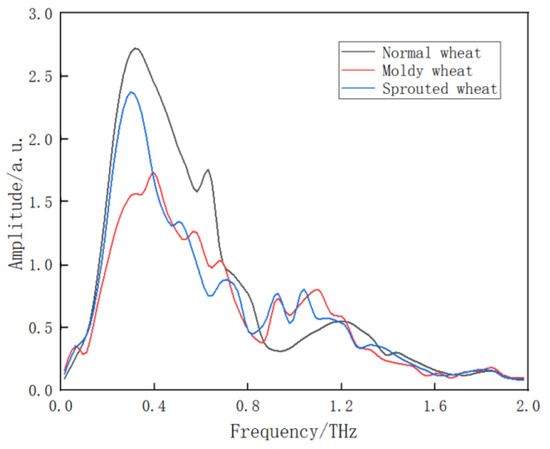
Figure 5.
The THz spectrum of the sample.
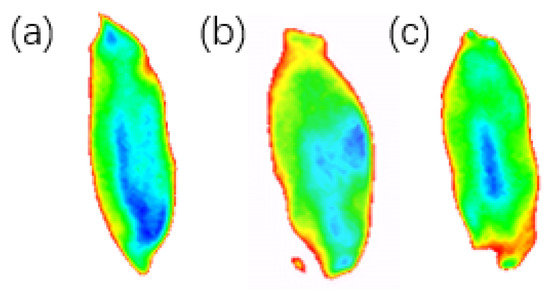
Figure 6.
The THz spectral images of wheat after background removal. (a) Normal wheat; (b) moldy wheat; (c) sprouted wheat.
As the wheat sample data acquisition equipment and environment are prone to dark current noise, short noise, etc., the original terahertz spectral images after background removal still had problems, such as poor image quality and outstanding features. This affects the accuracy of unsound wheat grain identification and other subsequent processing. In this work, five traditional image denoising algorithms, including block-matching and 3D filtering (BM3D) [31], denoising convolutional neural network (DnCNN) [32], weighted nuclear norm minimization (WNNM) [33], fast and flexible denoising convolutional neural network (FFDNet) [34] and the original CBDNet were compared with the proposed network in terms of image denoising.
Figure 7 shows the denoising effect of using six algorithms for normal, sprouted and moldy wheat kernels. The experimental results show that the algorithm proposed in this work performs better in comparison to other algorithms. The BM3D and WNNM failed to simulate the real noise, FFDNet lost the edge information while removing the noise and had an insufficient effect on the removal of the actual noise. The network proposed in this work has the best denoising effect as it simulates the real noise and retains the subject information. The PSNR and SSMI evaluation results are shown in Table 1.
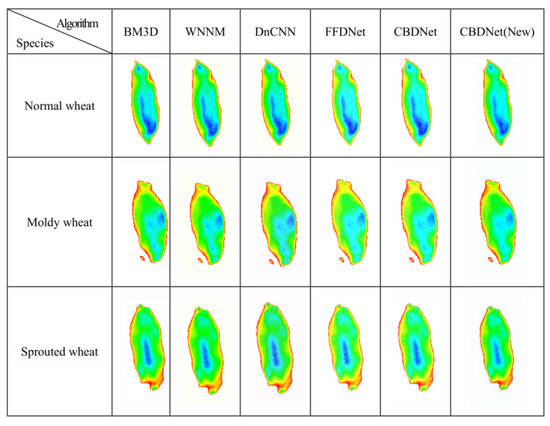
Figure 7.
The comparison of the results of each denoising network.

Table 1.
A comparison of PSNR/SSIM results based on denoising networks.
The network proposed in this work has better noise simulation capability with denoising ability. The highest PSNR/SSIM values are obtained for the proposed algorithm as compared to the conventional denoising algorithms. The PSNR/SSIM is 1.58 dB/0.16 higher than the original CBDNet, respectively. In addition, the time required for processing an image of size 180*200 is shortened from 1.0 s to 0.8 s.
In order to further consider the effects of different types of noise on the images, this work proposes to construct eight different noise models using different noise types, such as non-uniform Gaussian (HG), in-camera processing (ISP), pretzel noise (SPN) and gamma noise (GN) to fit the noise type that is closest to the real image. The denoising results of different noise models are shown in Figure 8. Table 2 shows the PSNR/SSIM results for different noise models.

Figure 8.
The comparison of the results of different noise models.

Table 2.
The PSNR/SSIM results for different noise models.
From Figure 8 and Table 2, the image processed by CBDNet (HG+SPN+GN+ISP), which is CBDNet (New), had the best image result compared with its noise model, and the PSNR and SSIM results of CBDNet (HG+SPN+GN+ISP) were as high as 39.237 dB and 0.94.
The proposed CBDNet (New) further improves the image quality in comparison to the traditional image denoising methods: however, some problems remain, such as the features are not prominent. Therefore, in this work, we adopted a VGG19 model for feature extraction from the denoised wheat sample images. In addition, we used the PReLU activation function to avoid the gradient disappearance and overfitting problems that occurred in the VGG19 model. The feature maps of the PReLU activation function after nonlinearization and the maximum pooling operation to obtain the feature maps of the three wheat samples are shown in Figure 9. As the number of layers of a network increases, the extracted feature maps become less informative, and the quality of the images becomes lower and lower. However, the feature map extracted by the second PReLU activation has clear features, and the image size does not change. This highlights the characteristics of the wheat samples as compared to the images processed only by CBDNet (New). The maximum signal value range increased from 255 to 1630. Therefore, the results obtained after the application of the second PReLU output in the VGG19 network were chosen as the output of the terahertz spectral image enhancement model based on the combination of CBDNet and VGG19.
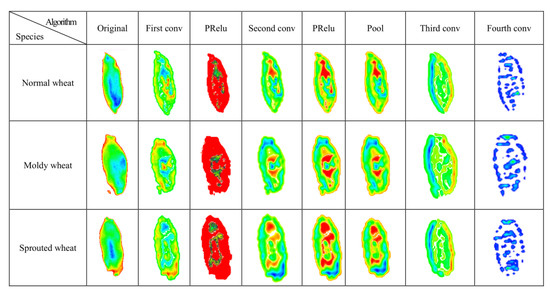
Figure 9.
The feature maps for different layers.
In order to verify the feasibility of the proposed CBDNet-V in terms of the identification of unsound wheat kernels, this work used the ResNet-50 classification network to classify and validate three unsound kernels of wheat. All the networks were trained for 500 epochs with an initial learning rate of 0.01 and batch size of 64. The experiments were divided into three data types, including denoised images, feature enhanced images and CBDNet-V processed images. The experimental results are shown in Table 3.

Table 3.
A comparison of classification results.
As presented in Table 3, the images obtained from the CBDNet-V terahertz spectral image enhancement model were validated by the ResNet-50 classification network. Compared to the images processed by using CBDNet (New) denoising and VGG19 feature extraction for normal wheat, the prediction accuracy improved from 91.1% and 92.9% to 94.8%, i.e., an improvement of 3.7% and 1.9%. The experimental results show that the prediction results of CBDNet-V terahertz spectral image enhancement model fit well with those of real wheat samples.
The CBDNet-V terahertz spectral image enhancement algorithm was compared to the classic image enhancement algorithms BM3D, DnCNN, WNNM and FFDNet in this article. The experimental results showed that CBDNet-V had the greatest PSNR and SSIM among the five approaches, as well as the best augmentation impact. The CBDNet-V algorithm successfully achieved the multi-directional denoising of images by simulating multiple denoising models and deep feature extraction by the feature extraction module to achieve feature enhancement of the terahertz spectral image of unsound wheat kernels, which effectively improved the image quality, highlighted the detail features, and reduced the detail loss significantly.
In future work, we will enlarge the dataset by adding multiple types of unsound wheat kernel samples in order to realize the detection and analysis of multiple unsound wheat kernels. Meanwhile, we will perfect the CBDNet-V terahertz image enhancement algorithm to improve the image enhancement capability of the algorithm. Improving the classification recognition accuracy of terahertz images of unsound wheat kernels in terms of a classification algorithm is also a focus in the future.
4. Conclusions
This study proposed a terahertz spectral image enhancement algorithm to remove the effects of noise and other factors during the acquisition of raw wheat imperfect grains, thus improving the terahertz spectral image quality and feature resolution. The characteristics of terahertz spectral images, such as the existence of a large amount of information, were discussed in this paper in order to explore the improvement direction of the CBDNet denoising algorithm and the VGG19 feature extraction algorithm. A terahertz image enhancement algorithm, CBDNet-V, was proposed, which can effectively enhance the image and improve the image quality. The algorithm proposed in this study obtained better results by constructing different noise models and comparing them with BM3D, FFDNet and DnCNN, etc. The PSNR is 39.30 dB and SSIM is 0.95. The classification accuracy of the model was verified by the ResNet50 classification network for unsound wheat seeds, and the classification accuracy was 94.8%. Furthermore, the recognition accuracy was improved by 3.7% and 1.9%, respectively, compared to the image with only denoising and the image with only feature extraction. Thus, this study provided a novel idea for terahertz spectral image feature enhancement.
Author Contributions
Data curation, F.W., X.C. and M.L.; formal analysis, L.L.; funding acquisition, Y.Z.; investigation, F.W. and G.L.; methodology, H.G.; project administration, Y.Z.; supervision, Y.J. and H.G.; validation, G.L. and X.C.; writing—original draft, F.W.; writing—review and editing, Y.J. All authors have read and agreed to the published version of the manuscript.
Funding
This work is supported by the National Natural Science Foundation of China (Grant Nos. 61975053, 61705061), the Key Science and Technology Program of the Henan Province of China (Grant Nos.222102110246), the Open Fund Project of Key Laboratory of Grain Information Processing and Control, Ministry of Education, Henan University of Technology (Grant No. KFJJ2020103, KFJJ2021102), Natural Science Foundation of Henan (Grant Nos.202300410111); Program for Science & Technology Innovation Talents in Universities of Henan Province (Grant Nos.22HASTIT017); Major public welfare projects of Henan Province (Grant Nos.201300210100); and the Cultivation Programme for Young Backbone Teachers of the Henan University of Technology.
Institutional Review Board Statement
Not applicable.
Informed Consent Statement
Not applicable.
Data Availability Statement
The data presented in this study are available on request from the corresponding author. The data are not publicly available due to [These data are part of an ongoing study].
Conflicts of Interest
There are no conflicts of interest in this article.
References
- Oviedo, M.S.; Ramirez, M.L.; Barros, G.G.; Chulze, S.N. Influence of water activity and temperature on growth and mycotoxin production by Alternaria alternata on irradiated soya beans. Int. J. Food Microbiol. 2011, 149, 127–132. [Google Scholar] [CrossRef] [PubMed]
- Oladunmoye, O.O.; Akinoso, R.; Olapade, A.A. Evaluation of some physical-chemical properties of wheat, cassava, maize and cowpea flours for bread making. J. Food Qual. 2010, 33, 693–708. [Google Scholar] [CrossRef]
- Carloni, E.; Amagliani, G.; Omiccioli, E.; Ceppetelli, V.; Del Mastro, M.; Rotundo, L.; Brandi, G.; Magnani, M. Validation and application of a quantitative real-time PCR assay to detect common wheat adulteration of durum wheat for pasta production. Food Chem. 2017, 224, 86–91. [Google Scholar] [CrossRef] [PubMed]
- Allmann, M.; Candrian, U.; Höfelein, C.; Lüthy, J. Polymerase chain reaction (PCR): A possible alternative to immunochemical methods assuring safety and quality of food. Detection of wheat contamination in non-wheat food products. Z. Lebensm.-Unters. Forsch. 1993, 196, 248–251. [Google Scholar] [CrossRef] [PubMed]
- Garcia-Febrero, R.; Salvador, J.P.; Sanchez-Baeza, F.; Marco, M.P. Rapid method based on immunoassay for determination of paraquat residues in wheat, barley and potato. Food Control 2014, 41, 193–201. [Google Scholar] [CrossRef]
- Zhao, J.; Zhang, X.; Yan, J.; Qiu, X.; Yao, X.; Tian, Y.; Zhu, Y.; Cao, W. A Wheat Spike Detection Method in UAV Images Based on Improved YOLOv5. Remote Sens. 2021, 13, 3095. [Google Scholar] [CrossRef]
- Sabanci, K. Detection of sunn pest-damaged wheat grains using artificial bee colony optimization-based artificial intelligence techniques. J. Sci. Food Agric. 2020, 100, 817–824. [Google Scholar] [CrossRef]
- Qiu, R.; Yang, C.; Moghimi, A.; Zhang, M.; Steffenson, B.J.; Hirsch, C.D. Detection of Fusarium Head Blight in Wheat Using a Deep Neural Network and Color Imaging. Remote Sens. 2019, 11, 2658. [Google Scholar] [CrossRef] [Green Version]
- Jiang, Y.; Ge, H.; Zhang, Y. Quantitative analysis of wheat maltose by combined terahertz spectroscopy and imaging based on Boosting ensemble learning. Food Chem. 2020, 307, 125533. [Google Scholar] [CrossRef]
- Cebi, N.; Dogan, C.E.; Develioglu, A.; Yayla, M.E.; Sagdic, O. Detection of L-Cysteine in wheat flour by Raman microspectroscopy combined chemometrics of HCA and PCA. Food Chem. 2017, 228, 116–124. [Google Scholar] [CrossRef]
- Zhang, L.; Ji, H.Y. Identification of wheat grain in different states based on hyperspectral imaging technology. Spectrosc. Lett. 2019, 52, 356–366. [Google Scholar] [CrossRef]
- Wu, Y.; Yun, Y.; Chen, J.; Liu, D. Discrimination of Waxy Wheats Using Near-Infrared Hyperspectral Spectroscopy. Food Anal. Methods 2021, 14, 1704–1713. [Google Scholar] [CrossRef]
- Sun, X.; Zhu, K.; Liu, J.; Hu, J.; Jiang, X.; Liu, Y.; Gong, Z. Terahertz spectroscopy determination of benzoic acid additive in wheat flour by machine learning. J. Infrared Millim. Terahertz Waves 2019, 40, 466–475. [Google Scholar] [CrossRef]
- Shen, Y.; Yin, Y.; Li, B.; Zhao, C.; Li, G. Detection of impurities in wheat using terahertz spectral imaging and convolutional neural networks. Comput. Electron. Agric. 2021, 181, 105931. [Google Scholar] [CrossRef]
- Zhang, J.; Yang, Y.; Feng, X.; Xu, H.; Chen, J.; He, Y. Identification of bacterial blight resistant rice seeds using terahertz imaging and hyperspectral imaging combined with convolutional neural network. Front. Plant Sci. 2020, 11, 821. [Google Scholar] [CrossRef] [PubMed]
- Zhai, Y.; Xiang, Y.; Yuan, W.; Chen, G.; Shi, J.; Liang, G.; Wen, Z.; Wu, Y. Fabrication of Graphene Nanomesh FET Terahertz Detector. Micromachines 2021, 12, 641. [Google Scholar] [CrossRef]
- Chen, G.; Li, Q. Markov chain Monte Carlo sampling based terahertz holography image denoising. Appl. Opt. 2015, 54, 4345–4351. [Google Scholar] [CrossRef]
- Liu, J.; Li, Z. Antcolony combined with adaptive threshold denoising and reconstruct for THz image. Optik 2014, 125, 3423–3427. [Google Scholar] [CrossRef]
- Zhang, Z.; Lu, Y.; Lv, C.; Mao, Q.; Wang, S.; Yan, S. Restoration of integrated circuit terahertz image based on wavelet denoising technique and the point spread function model. Opt. Lasers Eng. 2021, 138, 106413. [Google Scholar] [CrossRef]
- Guo, S.; Yan, Z.; Zhang, K.; Zuo, W.; Zhang, L. Toward convolutional blind denoising of real photographs. In Proceedings of the IEEE/CVF Conference on Computer Vision and Pattern Recognition, Long Beach, CA, USA, 15–20 June 2019; pp. 1712–1722. [Google Scholar]
- Song, Y.; Zhu, Y.; Du, X. Dynamic residual dense network for image denoising. Sensors 2019, 19, 3809. [Google Scholar] [CrossRef] [Green Version]
- Dey, N.; Zhang, Y.D.; Rajinikanth, V.; Pugalenthi, R.; Raja, N.S. Customized VGG19 architecture for pneumonia detection in chest X-rays. Pattern Recognit. Lett. 2021, 143, 67–74. [Google Scholar] [CrossRef]
- Theckedath, D.; Sedamkar, R. Detecting affect states using VGG16, ResNet50 and SE-ResNet50 networks. SN Comput. Sci. 2020, 1, 79. [Google Scholar] [CrossRef] [Green Version]
- He, K.; Zhang, X.; Ren, S.; Sun, J. Deep residual learning for image recognition. In Proceedings of the IEEE Conference on Computer Vision and Pattern Recognition, Las Vegas, NV, USA, 27–30 June 2016; pp. 770–778. [Google Scholar]
- Chan, R.H.; Ho, C.-W.; Nikolova, M. Salt-and-pepper noise removal by median-type noise detectors and detail-preserving regularization. IEEE Trans. Image Process. 2005, 14, 1479–1485. [Google Scholar] [CrossRef] [PubMed]
- Kamada, M.; Laitinen, A.; Zeng, W.; Will, M.; Sarkar, J.; Tappura, K.; Seppa, H.; Hakonen, P. Electrical Low-Frequency 1/f γ Noise Due to Surface Diffusion of Scatterers on an Ultra-low-Noise Graphene Platform. Nano Lett. 2021, 21, 7637–7643. [Google Scholar] [CrossRef]
- He, K.; Zhang, X.; Ren, S.; Sun, J. Delving deep into rectifiers: Surpassing human-level performance on imagenet classification. In Proceedings of the IEEE International Conference on Computer Vision, Washington, DC, USA, 7–13 December 2015; pp. 1026–1034. [Google Scholar]
- Setiadi, D.R. PSNR vs SSIM: Imperceptibility quality assessment for image steganography. Multimed. Tools Appl. 2021, 80, 8423–8444. [Google Scholar] [CrossRef]
- Shen, H.; Li, B.; Tao, M.; Wang, X. MSE-based transceiver designs for the MIMO interference channel. IEEE Trans. Wirel. Commun. 2010, 9, 3480–3489. [Google Scholar] [CrossRef]
- Sara, U.; Akter, M.; Uddin, M.S. Image quality assessment through FSIM, SSIM, MSE and PSNR—A comparative study. J. Comput. Commun. 2019, 7, 8–18. [Google Scholar] [CrossRef] [Green Version]
- Yang, D.; Sun, J. BM3D-Net: A convolutional neural network for transform-domain collaborative filtering. IEEE Signal Process. Lett. 2017, 25, 55–59. [Google Scholar] [CrossRef]
- Thakur, R.S.; Yadav, R.N.; Gupta, L. State-of-art analysis of image denoising methods using convolutional neural networks. IET Image Process. 2019, 13, 2367–2380. [Google Scholar] [CrossRef]
- Yang, H.; Park, Y.; Yoon, J.; Jeong, B. An improved weighted nuclear norm minimization method for image denoising. IEEE Access 2019, 7, 97919–97927. [Google Scholar] [CrossRef]
- Zhang, K.; Zuo, W.; Zhang, L. FFDNet: Toward a fast and flexible solution for CNN-based image denoising. IEEE Trans. Image Process. 2018, 27, 4608–4622. [Google Scholar] [CrossRef] [PubMed] [Green Version]
Publisher’s Note: MDPI stays neutral with regard to jurisdictional claims in published maps and institutional affiliations. |
© 2022 by the authors. Licensee MDPI, Basel, Switzerland. This article is an open access article distributed under the terms and conditions of the Creative Commons Attribution (CC BY) license (https://creativecommons.org/licenses/by/4.0/).